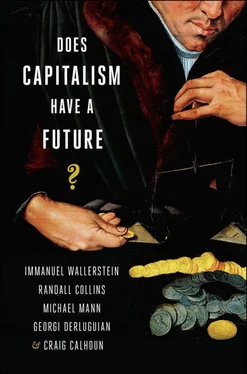Immanuel Wallerstein - Does Capitalism Have a Future?
Здесь есть возможность читать онлайн «Immanuel Wallerstein - Does Capitalism Have a Future?» весь текст электронной книги совершенно бесплатно (целиком полную версию без сокращений). В некоторых случаях можно слушать аудио, скачать через торрент в формате fb2 и присутствует краткое содержание. Город: New York, Год выпуска: 2013, ISBN: 2013, Издательство: Oxford University Press, Жанр: Публицистика, sci_economy, на английском языке. Описание произведения, (предисловие) а так же отзывы посетителей доступны на портале библиотеки ЛибКат.
- Название:Does Capitalism Have a Future?
- Автор:
- Издательство:Oxford University Press
- Жанр:
- Год:2013
- Город:New York
- ISBN:978-0-19-933084-3
- Рейтинг книги:5 / 5. Голосов: 1
-
Избранное:Добавить в избранное
- Отзывы:
-
Ваша оценка:
- 100
- 1
- 2
- 3
- 4
- 5
Does Capitalism Have a Future?: краткое содержание, описание и аннотация
Предлагаем к чтению аннотацию, описание, краткое содержание или предисловие (зависит от того, что написал сам автор книги «Does Capitalism Have a Future?»). Если вы не нашли необходимую информацию о книге — напишите в комментариях, мы постараемся отыскать её.
Does Capitalism Have a Future? — читать онлайн бесплатно полную книгу (весь текст) целиком
Ниже представлен текст книги, разбитый по страницам. Система сохранения места последней прочитанной страницы, позволяет с удобством читать онлайн бесплатно книгу «Does Capitalism Have a Future?», без необходимости каждый раз заново искать на чём Вы остановились. Поставьте закладку, и сможете в любой момент перейти на страницу, на которой закончили чтение.
Интервал:
Закладка:
Energy resources are perhaps the most prominent factors making violent conflict more likely but not the only ones. Water and arable land are perhaps as scarce. And beyond resources there are tensions over religion, migration, borders, and quasi-imperial desires to expand territories—not to mention tensions simply over evidence that neighbors are stockpiling weapons or acquiring nuclear capacity. A variety of dictators and nonstate actors are additional sources of instability and potential sparks to ignite conflict. And actual conflicts of the last decade—especially the invasion of Iraq and lingering war in Afghanistan—have both exacerbated tensions and reduced the capacity of the United States to complement its hegemonic power by effective policing. All this makes war more likely in the future, and makes it more likely that small-scale or regional conflicts will become drawn into larger-scale geopolitical conflicts. In many ways the forty-five years of the Cold War appear as an interlude in a longer history of geopolitical conflict and restructuring.
THE INFORMAL SECTOR AND ILLICIT CAPITALISM
Together financialization and neoliberalism weakened a variety of institutions crucial to stabilizing capitalism in the relatively rich Western countries. These included not only state regulatory institutions but also trade unions and even corporations. Business corporations that had seemed to be stable frameworks for individual careers ceased to provide health care, pensions, and long-term job security; in many cases they ceased to exist as their assets were traded in capital markets, stripped of any obligations to employees, communities, or business counterparts. Communities were undermined by disruption of economic bases and population movements. Formal organizations provided less and less of a safety net to ordinary citizens, and indeed fewer opportunities as well. The transition was not as sharp a shock as the crisis of institutions attendant on the fall of the U.S.S.R. but it moved in the same direction. Religious organizations stepped in not just with charity but also with a range of institutional services from employment to counseling. And throughout the OECD countries, local networks emerged to organize partially noncash economies of mutual exchange.
Weak formal institutions are associated with growth in the informal sector. The term derives from the efforts (notably by Arthur Lewis and Keith Hart) to describe Third World settings where formal institutions had not developed on a national scale and as a result the formally recorded, monetary economy contained only a fraction of total economic activity. The rest, crucial to the actual survival of much of the population, involved in varying combinations reliance on “traditional” social relations repurposed to provide support in new circumstances, development of new alternatives for formal market relations such as barter, and networks of face-to-face relationships in which transactions could be conducted without regard to law or taxation. Some of the informal sector activities would be classed as criminal, others not. But though the concept originated in studies of the Third World, it is clear that an informal sector has always accompanied capitalism and the efforts of nation-states to organize legal frameworks to support and cope with it.
The informal sector has expanded dramatically during the last forty years. It is an important dimension of economic life in rich countries as well as poor, an important part of how people have coped with poor performance of public institutions (as in the latter years of communism and formally planned economies), and central to how people have dealt with declining provision of public goods (not least in posttransition formerly communist countries but also in capitalist countries imposing regimes of neoliberalism and austerity). Much of this is organized on a community level: small-scale barter, cooperative associations, cash trade that evades both taxes and the financial industry. The informal sector is not simply a site of social problems. It is also a setting for creativity. The garage-based inventors and entrepreneurs who form something of a Silicon Valley myth often organized their nascent businesses informally (at least in periods when venture capital was hard to come by). So do similar entrepreneurs in India and Nigeria today. And so do filmmakers and artists. The informal sector can appear sometimes as bohemian, sometimes surprisingly middle class. Its dynamic, attractive businesses may or may not pay taxes, however, and their workers may or may not have pensions or health insurance.
The informal sector is not just local community networks and other face-to-face alternatives to formal markets and formal institutions. It also has a large-scale dimension of transnational capitalist structures that operate at least partially outside state institutions and laws. The latter include money-laundering, banking, and investments backed up by force as well as contracts. They include tax-evasion, trafficking, and a range of illicit flows—from minerals (blood diamonds or coltan), to weapons (small arms mostly, but also tanks, aircraft, and missiles), to drugs, to people. This often illicit capitalism is often more formally organized than the name “informal sector” suggests, and it has revenues and investments running into many trillions of dollars (though not surprisingly hard to calculate precisely).
The already substantial industry of tax evasion and illicit investment flows was dramatically heightened by the manner in which communism was replaced by capitalism in Russia. To a very large extent this involved the theft of state assets by former state agents and their transformation into a mixture of capitalist enterprise with organized crime. This helped to give rise to massive illicit trade and poured huge new amounts of money into an already thriving global network of illicit markets. Perhaps a trillion dollars worth of unrecorded capital flowed quickly from countries like Russia to tax-shelters like Cyprus and the Cayman Islands, and then in turn was invested in legal as well as illegal businesses back in Russia and around the world.
The importance of both relatively local informal sector activity and large-scale illicit capitalism reveal weaknesses in formally recorded capitalist growth. In the first place, this growth is unable to accomplish distribution necessary to sustain social life and reproduction. Formal capitalism actually depends on the informal sector to maintain the basic conditions of life in many societies—and thus the social peace necessary for prosperity of the parts of societies based on legitimate markets. This is particularly true in the parts of capitalist societies most affected by formal market failures—in slums, for example, where residents must rely largely on each other and very small-scale entrepreneurship to survive because both large-scale capitalism and the state are ineffective. But it is also true sometimes on larger scales, where corruption testifies not just to individual greed but also to institutional underdevelopment. Secondly, the large amounts of capital drawn into illicit global trade both implicitly tax or siphon funds from the formal sector and make markets and risks less predictable. Of course, capital from the illicit sector may also find its way into legitimate capital markets and into direct investment in legitimate businesses (where it may or may not be accompanied by illegitimate management tactics—like bribery or threats of violence). Informalization and corruption undercut needed state regulation and integrate legitimate businesses directly or indirectly with illegitimate ones like drug or sex trafficking.
Much of the global political economy is organized in ways that exceed the “official” world-system of nation-states and capitalism. Collusion between states and corporations, organized crime on various scales, the political power of warlords and cartels that hold no political office, and the economic power of semiautonomous parts of states including militaries all reveal a more complicated world—and one threatening to capitalism as we know it. So do cybersecurity challenges from Wikileaks to hacking, malware, spear-phishing, and other tactics deployed sometimes with state backing and sometimes by freelancers, sometimes against states and sometimes against corporations. This is part of the transformation of capitalism, not all without historical precedent, but with an unclear future.
Читать дальшеИнтервал:
Закладка:
Похожие книги на «Does Capitalism Have a Future?»
Представляем Вашему вниманию похожие книги на «Does Capitalism Have a Future?» списком для выбора. Мы отобрали схожую по названию и смыслу литературу в надежде предоставить читателям больше вариантов отыскать новые, интересные, ещё непрочитанные произведения.
Обсуждение, отзывы о книге «Does Capitalism Have a Future?» и просто собственные мнения читателей. Оставьте ваши комментарии, напишите, что Вы думаете о произведении, его смысле или главных героях. Укажите что конкретно понравилось, а что нет, и почему Вы так считаете.












